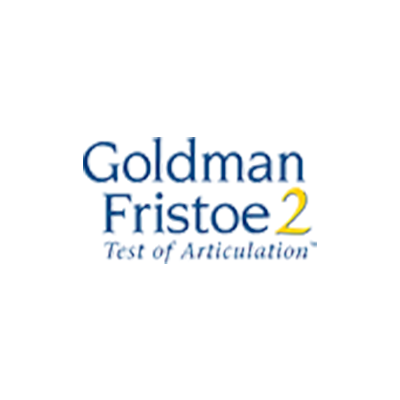Ronald Goldman, PhD, Macalyne Fristoe, PhD
Age Range:2:0 - 21:11
RTI Tiers:RTI Levels 1, 2 and 3
Completion Time:5 to 15 minutes for Sounds-in-Words Section, varied for other two sections
Telepractice:Tips on using this test in your telepractice
Norms:Restandardized norms have been expanded to include ages 2-21 with separate normative tables for males and females.
Still the most popular articulation test available.
The second edition of the Goldman-Fristoe Test of Articulation gives you updated norms and expanded features, and it remains accurate and easy to administer.
The test provides information about a child’s articulation ability by sampling both spontaneous and imitative sound production. Examinees respond to picture plates and verbal cues from the examiner with single-word answers that demonstrate common speech sounds. Additional sections provide further measures of speech production.
Use this test to measure articulation of consonant sounds, determine types of misarticulation, and compare individual performance to national, gender-differentiated norms.
New items, new artwork, new age range, new norms
- New items have been added to sample more speech sounds—39 consonant sounds and clusters can now be tested with the Goldman-Fristoe 2. Some objectionable or culturally inappropriate items (e.g., gun, Christmas tree) have been removed.
- All artwork has been redrawn and reviewed for cultural bias and fairness.
- The age range for the Goldman-Fristoe 2 has been expanded to include ages 2 through 21. Age-based standard scores include separate normative information for females and males.
- Normative tables are based on a national sample of 2,350 examinees stratified to match the most recent U.S. Census data on gender, race/ethnicity, region, and SES as determined by mother’s education level.
Goldman-Fristoe 2 retains the best features of the original test

The second edition keeps the features that made the original Goldman-Fristoe Test of Articulation efficient and easy to use.
- Test 3 – User-friendly color-coding for recording initial-medial-final sounds
- Multiple testing of speech sounds within a word or plate for efficient test administration
- Broad sampling of the consonant sounds and clusters used in Standard American English
- Opportunity to sample both spontaneous and imitated production of speech sounds
Supplemental Developmental Norms Booklet
Organizations find the Supplemental Developmental Norms Booklet included in the kit advantageous. With it they can use the norms—based on developmental data—to set their own cutoff criteria for intervention services qualification.
Easy to administer
Sounds-in-Words uses colorful, entertaining pictures to prompt responses that sample the major speech sounds in the initial, medial, and final positions. Suggested cues have been added for the examiner to help elicit spontaneous responses by the examinee.
Additional sections provide a fuller sampling of the examinee’s ability to produce speech sounds and to reproduce sounds when modeled by the examiner.
With streamlined test administration, the Goldman-Fristoe 2 is an efficient way to obtain a representative sample of an examinee’s articulation ability.
Three sections sample a wide range of articulation skills
- Sounds-in-Words Section uses pictures to elicit articulation of the major speech sounds when the examinee is prompted by a visual and/or verbal cue.
- Sounds-in-Sentences Section assesses spontaneous sound production used in connected speech. The examinee is asked to retell a short story based on a picture cue. Target speech sounds are sampled within the context of simple sentences.
- Stimulability Section measures the examinee’s ability to correctly produce a previously misarticulated sound when asked to watch and listen to the examiner’s production of the sound. The examinee repeats the word or phrase modeled by the examiner.
Increase your assessment clarity
The KLPA-2 (Khan-Lewis Phonological Analysis) works with the Goldman-Fristoe 2 to give you a more comprehensive diagnosis of both articulation and use of phonological processes. Save when you purchase the two kits together.
Visit SpeechandLanguage.com for more information
Visit the www.SpeechandLanguage.com web site for additional information and the SLP Forum discussion center.
Increase efficiency with computer scoring and reporting
 The ASSIST software program is available to help score, calculate, and compare normative data for both Goldman-Fristoe 2 and KLPA-2 tests. At the touch of a button you can print out separate score summaries for the Goldman-Fristoe 2 and KLPA-2. Or print out a combined report for detailed diagnostic information. Reports are easy to customize by test section and diagnostic topic; a Recommendations section even has summary text. You also can set a local criterion to obtain developmental norms comparisons from the biggest and best standardization sample to date!
The ASSIST software program is available to help score, calculate, and compare normative data for both Goldman-Fristoe 2 and KLPA-2 tests. At the touch of a button you can print out separate score summaries for the Goldman-Fristoe 2 and KLPA-2. Or print out a combined report for detailed diagnostic information. Reports are easy to customize by test section and diagnostic topic; a Recommendations section even has summary text. You also can set a local criterion to obtain developmental norms comparisons from the biggest and best standardization sample to date!
Materials
Goldman-Fristoe 2 Technical Information
GFTA-2/KLPA-2 Sample ASSIST Printouts
An Additional Word About Interpreting Goldman-Fristoe 2 Scores
Goldman-Fristoe 2 Conversion Table for Use with KLPA
Training Video: GFTA-2 on Q-interactive
Pre-recorded Webinars
-
Transitioning From GFTA-2 to GFTA-3: Interpreting & Communicating Test Results
Presenter: Chien (Shannon) Wang, M.A. Senior Research Director

GFTA-2/GFTA-3 scores may differ significantly, especially with children exhibiting certain error patterns. GFTA-3 research data showing age of emergence vs. mastery of speech sounds, combined with test scores, provide clinicians with data needed to make appropriate interpretations of test results and convey results in a meaningful way to stakeholders.
Date: Sep 13, 2017
 PDF: Transitioning From GFTA-2 to GFTA-3: Interpreting & Communicating Test Results
PDF: Transitioning From GFTA-2 to GFTA-3: Interpreting & Communicating Test Results Video: Transitioning From GFTA-2 to GFTA-3: Interpreting & Communicating Test Results
Video: Transitioning From GFTA-2 to GFTA-3: Interpreting & Communicating Test Results -
Goldman-Fristoe 2: Research, Administration, and Interpretation
Presenter: Ronald Goldman

Questions
Frequently asked questions follow. Click on a question to see the response.
Test Content
- Why are words such as duck, yellow, and flowers which have phonetic contexts easily influencing assimilation errors still used?
- Why is there no inclusion of vowel production as in the Arizona Test of Articulation?
- Has a study been done that looks at which format is “better” pictures vs. photographs?
- Are there plans to update the GFTA-KLPA-2 normative data?
- When you anticipate production of a new edition?
- It would be great if the test tested for post vocalic “r.”
- Will there ever be a normed intelligibility section?
- Do you anticipate a Spanish version in the near future?
- Will there be an iPad application?
Administration
- If a student has met all of his goals and objectives and is ready to exit speech therapy…is it necessary to give him the full assessment of the Goldman-Fristoe-2?
Scoring
- If a child’s production of a sound is perceptually accurate, but the placement is incorrect (i.e. interdentalization of /t, d, n/, how would that be scored?
- If a child does not have an /s/ in his or her repertoire, marking all the /s/ blends as incorrect seems to skew the score somewhat. Have I been scoring this correctly?
- The target sound in the picture balloons is the medial /l/. However, if the child has difficulty producing the /s/ sound, do you count that error when finding the raw score or only the target sound for each picture?
- The raw score is determined from the Sounds in Words section of the test. If a child scored 0 for their raw score but had 6 errors on Sounds in Sentences–could those errors be counted for a ‘raw score’?
- How do recommend interpreting scores for a child around age 2 ½ who is administered the test but responds to very few pictures, even in imitation. His non-responses are not counted as errors, so his score is inflated.
- I’m still not sure how to use the Supplemental Developmental Norms to interpret child’s performance.
- In reference to the normative table for sound development, what is the exact chronological age for which the sample correctly produced the sounds? For example /b/ in initial position words, is it delayed at two years, zero months?
- Table 2.1 states age at which 85% participants accurately produced by age. You indicated that there was a chart available for medial and final. Can you give the table and/or reference for that?








